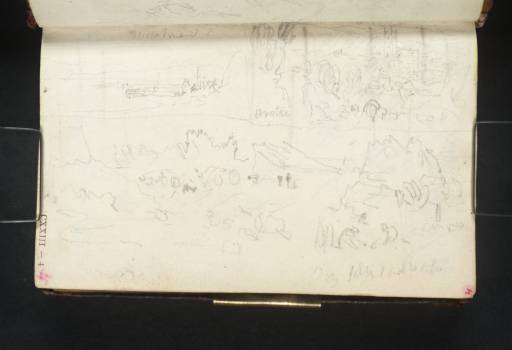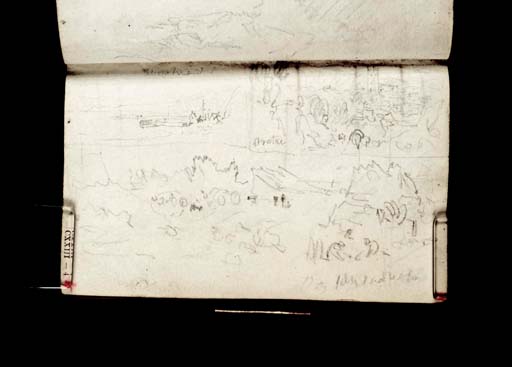Joseph Mallord William Turner Minehead; ?Stratton; a Rocky Coastal Scene, Possibly at Bude 1811
Image 1 of 2
Joseph Mallord William Turner,
Minehead; ?Stratton; a Rocky Coastal Scene, Possibly at Bude
1811
Joseph Mallord William Turner 1775–1851
Folio 4 Recto:
Minehead; ?Stratton; a Rocky Coastal Scene, Possibly at Bude 1811
D08368
Turner Bequest CXXIII 4
Turner Bequest CXXIII 4
Pencil on white wove writing paper, 75 x 117 mm
Part watermark ‘th | 6’
Inscribed by Turner in pencil ‘Minehead’ top left, ‘[?Stratton]’ centre, and ‘[?Boy sellg sand to ...]’ bottom right
Inscribed twice by John Ruskin in red ink ‘4’ bottom right and bottom left, descending vertically
Stamped in black ‘CXXIII – 4’ bottom left, descending vertically
Part watermark ‘th | 6’
Inscribed by Turner in pencil ‘Minehead’ top left, ‘[?Stratton]’ centre, and ‘[?Boy sellg sand to ...]’ bottom right
Inscribed twice by John Ruskin in red ink ‘4’ bottom right and bottom left, descending vertically
Stamped in black ‘CXXIII – 4’ bottom left, descending vertically
Accepted by the nation as part of the Turner Bequest 1856
Exhibition history
1997
Turner’s Watercolour Explorations 1810–1842, Tate Gallery, London, February–June 1997, Southampton City Art Gallery, June–September 1997 (42, as ‘North Devon or Cornish Coastal Scene’).
References
1909
A.J. Finberg, A Complete Inventory of the Drawings of the Turner Bequest, London 1909, vol.I, p.344, CXXIII 4, as ‘Three views, one of “Minehead.”’.
1997
Eric Shanes, Turner’s Watercolour Explorations 1810–1842, exhibition catalogue, Tate Gallery, London 1997, p.59 no.42, as ‘North Devon or Cornish Coastal Scene’.
Turner’s three inscriptions relate respectively to the two small views occupying the top third of the page to left and right, and the more substantial beach scene below, where the inscription tentatively transcribed above may be a commentary on the activities of the figures just above it. The three drawings are separated by vertical and horizontal pencil lines.
The view of Minehead shows the pier with the coast to the south-east beyond. There is a view of what seems to be Minehead Harbour on folio 205 recto (D08732; CXXIII 202), distant views from the coast to the south on folios 132 recto, 165 verso, 171 verso and 213 verso (D08613, D08672, D08683, D08747; CXXIII 129, 162a, 168a, 210a) and a drawing from the south in the contemporary Somerset and North Devon sketchbook (Tate D08956; Turner Bequest CXXVI 10).
The sketch at the top right may show Stratton, with the tall tower and low south aisle of St Andrew’s Church, just inland from Bude (see below) on the main road leading north towards Clovelly (see folios 224 verso–225 recto and 226 recto; D41521, D08765, D08766; Turner Bequest CXXIII 221 verso, 222, 223). There may be pack animals in the foreground, possibly on what is now Union Hill. Today, the church is obscured by buildings and trees from here, but a comparable view of the tower and distant hills is from the junction of Bentley Drive and the main road just north of Union Hill.
Eric Shanes has discussed the lower drawing in relation to an unfinished watercolour (Tate D25423; Turner Bequest CCLXIII 300),1 which he suggests is an abandoned design of about 1823 for the Picturesque Views on the Southern Coast (see the 1811 West Country tour introduction). Because of the particular formation of the rocks and their brown tint in the watercolour, he concludes that they are of sandstone, thus limiting the possibilities to Cornwall and North Devon, probably ‘on the west-facing coasts of the Hartland peninsula, or between Saunton Sands and Morte Point, Devon’. The beaches in that area are full of lime-rich sea shells, and Turner seems to be recording ‘sand-landing’ – the removal of sand to be used on local agricultural land to neutralise the soil.2 There seem to be carts in the distance approaching a vessel, its sail visible above the rocks to the left. In the equivalent position in the watercolour is a ship which Shanes suggests may be bringing lime from South Wales.
There is a further note about ‘sand’ inscribed on a view of Bude on folio 24 verso (D08407), and there is a view from the neighbourhood towards Lundy island on folio 250 verso (D08801; CXXIII 247a). Other views of that stretch of coast are in the contemporary Cornwall and Devon sketchbook (Tate D41311, D41312, D41318, D41345, D41350, D41352; Turner Bequest CXXV a 35, 35a, 40, 63, 68, 70). D41318 shows jagged, vertical sandstone rocks in the foreground, similar to those in the present sketch, which perhaps records activity in the area, while D41345 is a detailed study of what may be the same formation, or one of a very similar character; D41350 appears to show the same scene.
Matthew Imms
June 2011
How to cite
Matthew Imms, ‘Minehead; ?Stratton; a Rocky Coastal Scene, Possibly at Bude 1811 by Joseph Mallord William Turner’, catalogue entry, June 2011, in David Blayney Brown (ed.), J.M.W. Turner: Sketchbooks, Drawings and Watercolours, Tate Research Publication, December 2012, https://www


